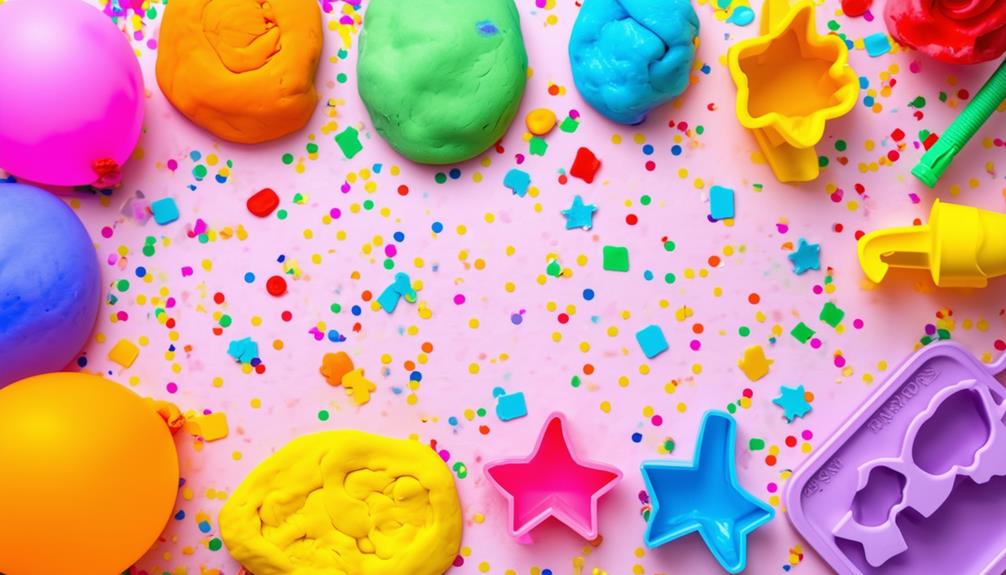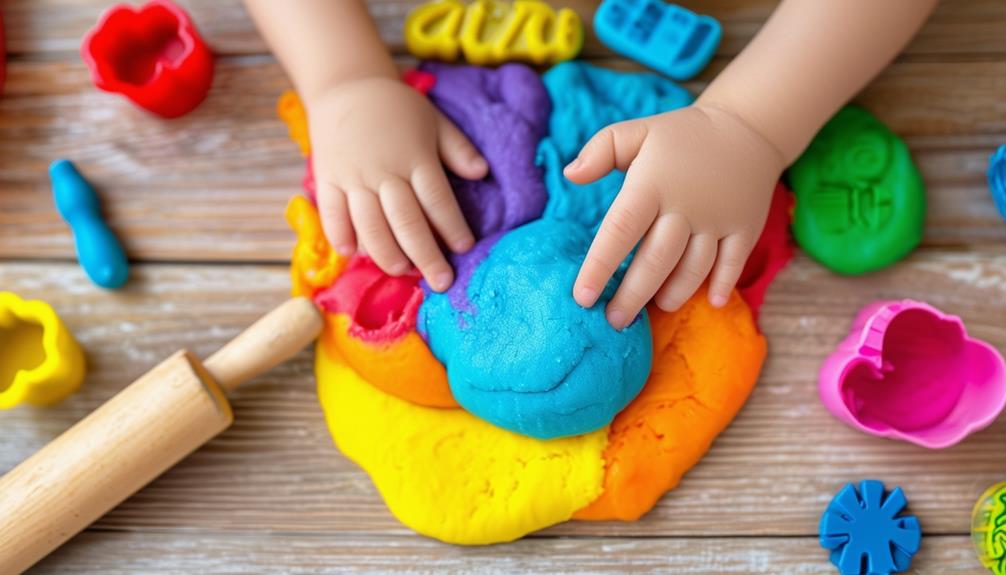Toys Similar to Play Dough
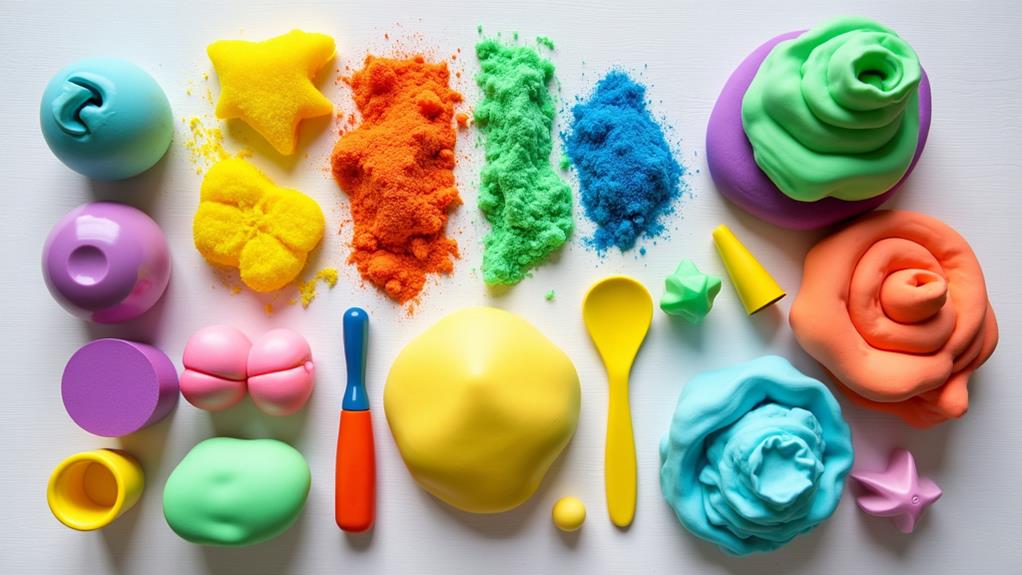
When seeking alternatives to Play Dough, a variety of options cater to both creativity and sensory play. Have you considered Play Foam or Floam? These mess-free materials are excellent for reusable play sessions. Homemade and store-bought slime offer different tactile experiences. Moldable clays like air-dry and polymer clay are great for detailed projects. Additionally, kinetic sand, edible play materials, and stress relief toys each provide unique benefits. There's a lot to explore in the exciting world of creative play.
Foam-Based Play Materials
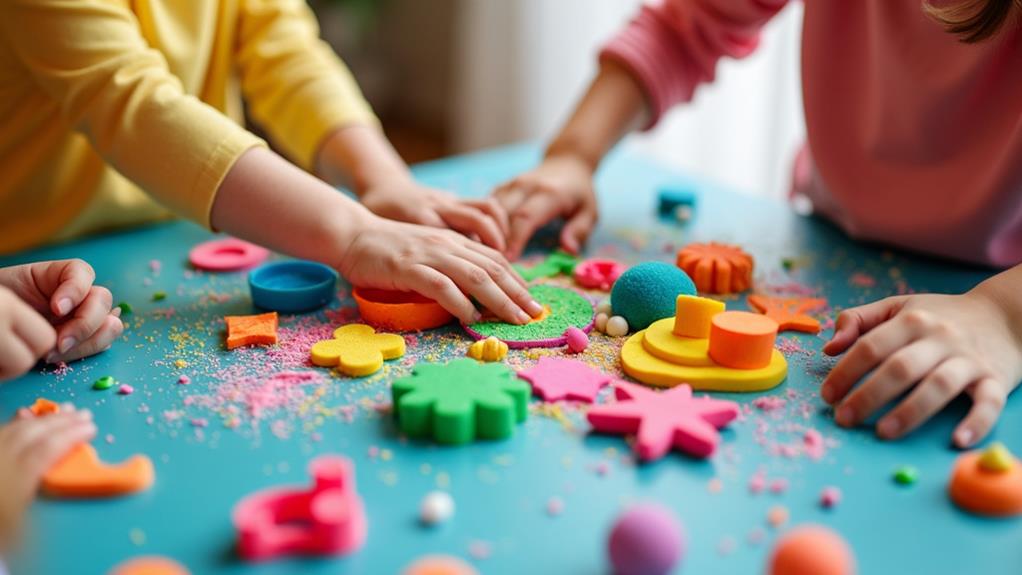
Foam-based play materials like Floam and Play Foam offer unique qualities and benefits that make them excellent choices for children's activities. Both materials are safe and engaging, providing a fun sensory experience.
Floam consists of tiny, sticky foam pieces that easily mold together, yet do not adhere to clothes or surfaces, simplifying cleanup. It is recommended for children aged 3 and up, with supervision advised due to potential choking hazards.
Play Foam is a lightweight, reusable, and mess-free option that allows children to shape and sculpt in various colors. A set typically costs around $10. Unlike traditional doughs, Play Foam does not dry out, allowing for repeated use and making it a cost-effective option for parents.
Both Floam and Play Foam are excellent for sensory play, promoting creativity through tactile engagement. Their mess-free nature and durability make them practical choices for quiet play. These materials are ideal alternatives to traditional doughs, offering an easy-to-clean and long-lasting solution for parents seeking engaging activities for their children.
Slime Varieties
Exploring the world of slime varieties offers a fantastic sensory play experience with endless customization options. Easily made at home using basic ingredients like glue and borax, slime's texture and color can be tailored to your preferences. Store-bought slime is also affordable, with prices starting as low as $3 for a 6-pack.
For a unique twist, consider pudding slime. Made from pudding mix, it's safe and edible, providing a delightful sensory experience suitable for all ages. While slime is particularly popular among children aged 5-12, younger kids can also enjoy it under close supervision due to its sticky nature.
Though engaging and fun, slime can be messy. Its stickiness makes it difficult to clean from fabrics, so it's best to play with it in easy-to-clean areas. Despite the mess, the sensory benefits and creative possibilities make slime a popular choice for many families. Just be prepared for a bit of cleanup afterward!
Moldable Clays
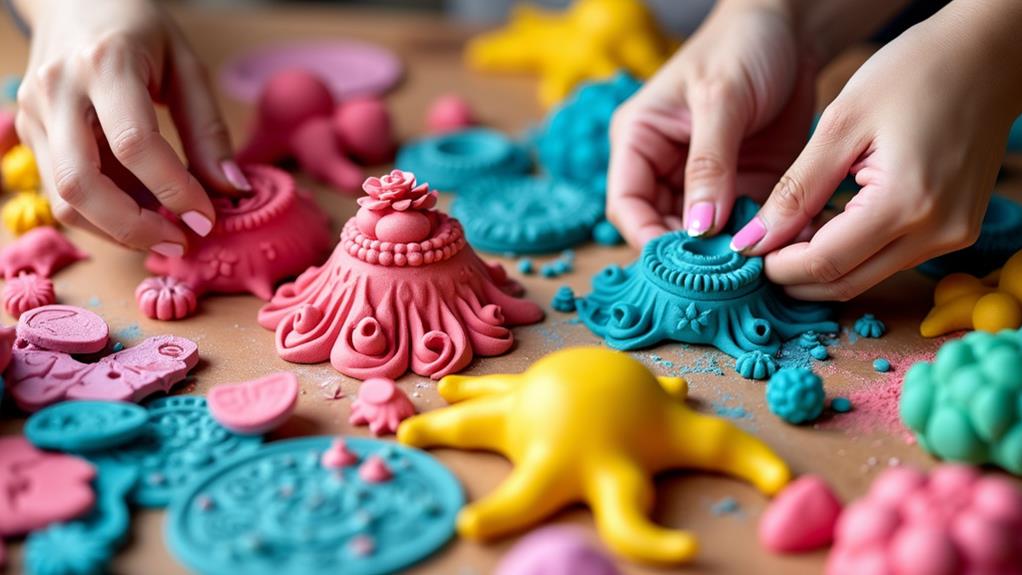
Moldable clays offer a versatile and engaging alternative to Play Dough, providing a broad spectrum of creative opportunities. Whether you're delving into artistic pursuits or aiding older children in enhancing their sculpting skills, there's a type of clay suited for every project.
Air-Dry Clay is an excellent choice for creating lasting sculptures. It is easy to mold and hardens naturally when exposed to air, resulting in durable keepsakes.
Fimo or Polymer Clay is ideal for intricate work. This oven-bake clay enables detailed creations once heated, making it perfect for older children and adults interested in fine art projects.
Modeling Clay varies in hardness levels, offering flexibility for different types of creations. Some types require baking and typically range in price from $5 to $20. This clay is great for older children, though it often requires adult supervision due to its detailed nature.
For those interested in DIY projects, DIY Baking Soda Dough is a wonderful, inexpensive option. Composed of baking soda, cornstarch, and water, it provides a safe and creative molding experience that hardens over time.
Summary:
- Air-Dry Clay: Naturally hardens, ideal for lasting sculptures.
- Fimo or Polymer Clay: Oven-bake for detailed, professional-quality creations.
- Modeling Clay: Comes in different hardness levels, offering flexibility.
- DIY Baking Soda Dough: Easy, safe, and hardens over time.
Each type of moldable clay offers unique advantages, making them excellent alternatives to traditional Play Dough.
Sensory Play Materials
Exploring moldable clays reveals a world of creative possibilities, but sensory play materials elevate hands-on fun to a new level. Kinetic Sand is a standout choice, offering a mess-free tactile experience since it sticks to itself rather than surfaces. It's excellent for building fine motor skills and provides endless entertainment.
Mad Mattr is another favorite. This super-soft, dough-like material is non-toxic, gluten-free, and never dries out, making it ideal for open-ended creative play. If you're seeking a different texture, try Play Foam. This lightweight, pliable foam can be shaped and sculpted into various forms. It's mess-free, easy to clean, and suitable for kids of all developmental stages. A set with multiple colors is available for around $10.
Floam consists of tiny, sticky foam pieces that come in assorted colors and never dry out. It's safe for children aged 3 and older, offering a fun, reusable option for creativity. Clean Mud, made from common household ingredients, provides a squishy texture similar to traditional dough and is easy to clean up.
These sensory play materials offer endless opportunities for imaginative, hands-on fun, enhancing both creativity and motor skills in a safe and engaging manner.
Edible Play Materials
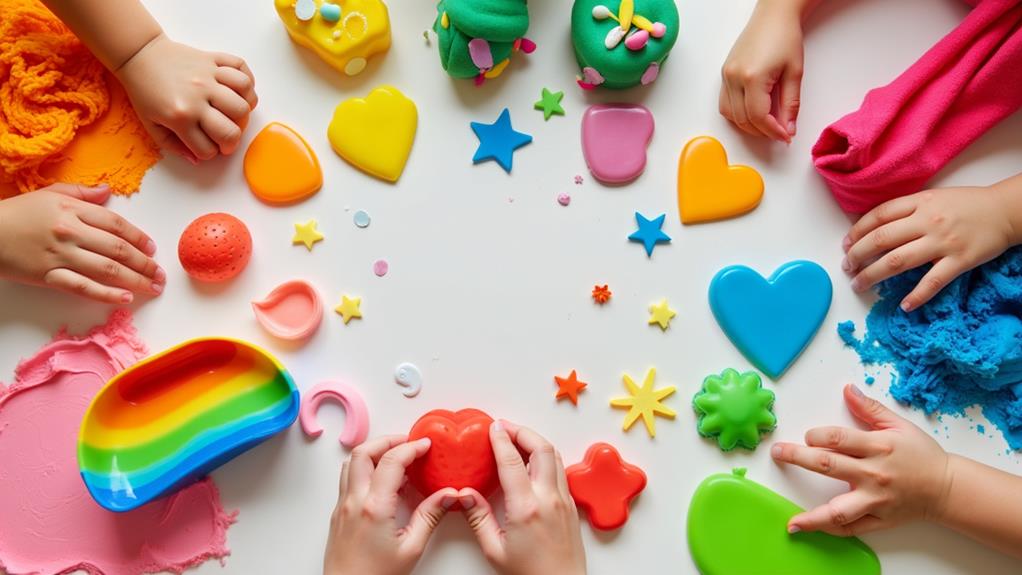
Edible play materials offer a delightful blend of sensory exploration and safety, providing food-grade options for children to enjoy without the risk of choking hazards. Picture the joy on their faces as they mold and shape colorful, flavorful dough that is safe to taste and even eat.
These materials foster a unique sensory experience, promoting creativity and exploration. Homemade edible play dough can be made easily with simple ingredients like flour, water, and food coloring, making it a fun and cost-effective activity, typically costing around $5 for a small batch.
Here are some engaging ideas:
- Brightly Colored Dough: Add food coloring for vibrant, appealing play materials.
- Flavored Dough: Incorporate extracts like vanilla or cocoa powder to enhance the scent and taste.
- Textured Dough: Mix in oats or rice for an added sensory dimension.
Homemade edible play dough is suitable for children of all ages, offering safe and imaginative play. Dive into this exciting, tasty realm of sensory play and watch your children's creativity flourish.
Stress Relief Toys
Stress relief toys like stress balls offer a valuable avenue for sensory play and relaxation. These small, squishy toys can be squeezed or tossed, providing sensory input without the mess often associated with traditional sensory materials. Stress balls come in various colors and patterns, allowing for personalization that keeps children engaged.
By squeezing and manipulating these toys, children improve their fine motor skills, enhancing hand strength and dexterity. This makes stress balls a fantastic tool for developing those vital skills in a fun and interactive way. Prices start at around 40 cents each, making them an affordable option for stress relief and sensory play.
Beyond their educational benefits, stress balls are widely recognized for their calming effects. They're especially effective at reducing anxiety, making them suitable for both children and adults seeking stress relief. However, they are not recommended for children under 3 due to choking hazards. Incorporating stress balls into your routine can promote a sense of calm and help manage daily stress, making them a versatile addition to any household.
Unique Textured Materials
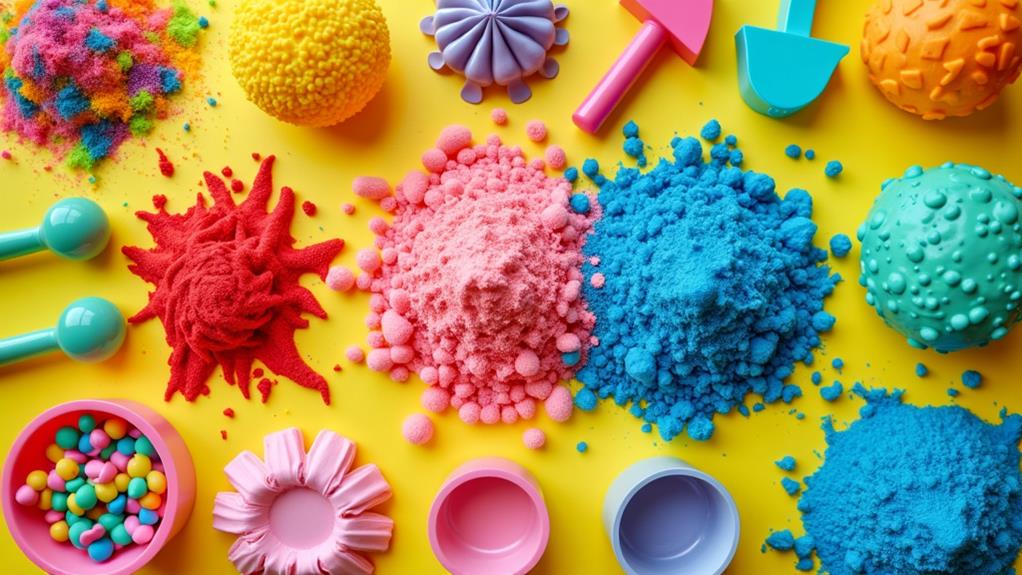
Unique textured materials offer an exciting alternative to traditional Play Dough, providing diverse sensory experiences that captivate children's interest and aid in their sensory development.
Silly Putty: This stretchy, elastic material not only bounces but also comes in various colors, making it perfect for children aged 2 years and older. It provides a unique tactile experience without drying out.
Floof: Softer and smoother than Play Dough, Floof is a lightweight modeling material ideal for creating intricate shapes. Although available only in basic white, its texture allows children to explore their creativity in new ways.
Mad Mattr: Combining the properties of Play Dough and Kinetic Sand, Mad Mattr is a versatile option. It is non-toxic, gluten-free, and sticks to itself, ensuring a mess-free playtime for kids aged 3 years and older.
These materials not only entertain but also improve sensory development, making them excellent additions to any child's playtime toolkit.
Homemade Doughs
Homemade doughs are an excellent choice for easy, safe, and budget-friendly play materials. You can create various types like Baking Soda Dough or Edible Play Dough using simple kitchen ingredients. These DIY recipes not only save money but also offer fantastic sensory play benefits for children of all ages.
Easy DIY Recipes
Creating homemade doughs can be both fun and cost-effective, providing endless opportunities for creative play. Here are several easy DIY recipes you can try at home to keep kids entertained and engaged:
- Baking Soda Dough: Mix baking soda, cornstarch, and water to create a moldable dough that hardens when dried. This is perfect for making ornaments and sculptures.
- Edible Play Dough: Combine flour, water, and food coloring to create a safe, edible dough. You can even add flavoring for extra fun, making it a delicious and sensory experience for younger children.
- Clean Mud: Mix glue and shaving cream for a squishy texture that's easy to clean up. This dough offers a sensory play experience without the mess associated with traditional doughs.
- Homemade Kinetic Sand: Combine sand, cornstarch, and water to create a tactile experience similar to store-bought kinetic sand. While it may not perfectly match the commercial texture, it still provides plenty of moldable fun.
These recipes offer a range of sensory experiences and creative possibilities, ensuring hours of enjoyable play for kids.
Safe for Kids
Homemade doughs are a fun, safe, and budget-friendly way to keep kids entertained. Using common household ingredients, you can create various doughs that are safe for children. For example, Baking Soda Dough, made from baking soda, cornstarch, and water, is easy to mold and hardens when dried, making it ideal for creating ornaments or sculptures.
Another exciting option is Oobleck, a mixture of cornstarch and water that behaves like both a solid and a liquid. Adding food dye can make it even more engaging. For younger children, Edible Dough, made from ingredients safe enough to taste, eliminates choking hazards and allows for sensory exploration.
Clean Mud, crafted from simple household items, offers a squishy texture similar to traditional dough and is easy to clean up, ensuring a mess-free experience. These homemade doughs are typically inexpensive, often costing under a dollar to make, providing a cost-effective way to keep children creatively engaged while ensuring their safety. Whether it's Baking Soda Dough, Oobleck, Edible Dough, or Clean Mud, you have plenty of safe and enjoyable options to choose from.
Sensory Play Benefits
Engaging in sensory play with homemade doughs provides children not only with fun but also with opportunities to develop crucial fine motor skills and creativity. Homemade doughs like baking soda dough and oobleck offer cost-effective, safe, and enjoyable alternatives for children aged 3 years and older, providing a rich range of sensory experiences.
Baking soda dough is easy to make with common household ingredients. It is excellent for molding and texturing, allowing children to create various shapes, such as ornaments or sculptures that harden when dried. Oobleck, made from cornstarch and water, offers a unique educational experience by behaving like both a solid and a liquid, helping children learn about states of matter in an engaging way.
What makes homemade doughs so captivating includes:
- Customizable Colors and Scents: Enhance sensory engagement by adding different colors and scents.
- Low Mess: Easier to clean up compared to traditional options like Play Dough.
- Versatility: Encourages creativity and experimentation with different shapes and textures.
These attributes make homemade doughs a valuable tool for sensory play, promoting both learning and fun.
Craft Kits

Why settle for plain play dough when you can immerse yourself in the vibrant world of craft kits? These pre-packaged sets provide a structured yet imaginative experience that surpasses simple dough. Craft kits not only offer hours of creative play but also significantly enhance fine motor skill development. Made with non-toxic materials, these kits ensure safety as your child explores various themes and designs.
Dough kits typically include a variety of tools and themed molds, ideal for guided creative play. Starting at around $10, these kits are a budget-friendly way to enrich your child's playtime. For a more specific experience, themed dough craft kits are an excellent choice. Priced at approximately $15, they often feature molds for creating specific items like animals or food, adding an educational element to the fun.
Here's a quick comparison to help you choose:
| Kit Type | Features | Price |
|---|---|---|
| Dough Kits | Basic tools and dough | $10 |
| Themed Dough Kits | Specific molds, creative themes | $15 |
| Deluxe Craft Kits | Multiple colors, accessories | $20+ |
Craft kits come with an array of colors and accessories, offering endless possibilities for your child's imagination. So why stick to plain play dough when so many enriching options are available?

